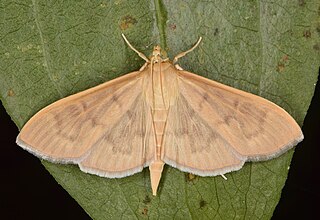Notioplusia illustrata, the notioplusia moth, is a moth of the family Noctuidae first described by Achille Guenée in 1852. It is native to Saint Kitts, the Greater Antilles, Florida, Mexico, Panama and South America. It was introduced to Australia and South Africa.
Ethmia albitogata is a moth in the family Depressariidae. It is found in central California.
Ethmia nadia is a moth in the family Depressariidae. It is found in California.
Ethmia abraxasella is a moth in the family Depressariidae. It is found in Jamaica, Haiti, the Dominican Republic, Puerto Rico, Cuba and the Bahamas. It has also been recorded from southern Florida in the United States.
Ethmia nivosella is a moth in the family Depressariidae. It is found in the West Indies, from Jamaica and eastern Cuba to the Bahamas and Puerto Rico. It might also be present in Haiti, the Dominican Republic and Trinidad.

Ethmia elutella is a moth in the family Depressariidae. It is found from Panama to Venezuela and Trinidad. There is also a record from Chile.

Ethmia janzeni is a moth in the family Depressariidae. It is found from Mexico to San Salvador, as well as in north-western Costa Rica. The habitat consists of dry forests and rain forests.
Ethmia notatella is a moth in the family Depressariidae. It is found in the Florida Keys, the Bahamas, Hispaniola, Puerto Rico and the Lesser Antilles (Curacao).
Ethmia cubensis is a moth in the family Depressariidae. It is found in Cuba and Jamaica.
Ethmia confusella is a moth in the family Depressariidae. It is found from the Florida Keys and Bahamas, through the Greater Antilles to the Yucatan Peninsula, and through the Lesser Antilles to Trinidad.
Jocara majuscula is a species of snout moth in the genus Jocara. It was described by Gottlieb August Wilhelm Herrich-Schäffer in 1871, and it is found in California, Florida, Central America, Cuba, Puerto Rico and Jamaica.
Leucania inconspicua is a moth of the family Noctuidae first described by Gottlieb August Wilhelm Herrich-Schäffer in 1868. It is found in Florida, Cuba, Puerto Rico, Jamaica, the Lesser Antilles and from Mexico to Brazil.

Melipotis acontioides, the royal poinciana moth, is a species of moth in the family Erebidae. It was first described by Achille Guenée in 1852. The species is found from the southern United States through Mexico and Central America to Brazil, Argentina and the Galápagos Islands. It is also found in the Caribbean, including Cuba and the British Virgin Islands, Jamaica and Puerto Rico.

Microcrambus biguttellus, the gold-stripe grass-veneer, is a moth in the family Crambidae. It was described by William Trowbridge Merrifield Forbes in 1920. It is found in North America, where it has been recorded from Alabama, Florida, Georgia, Illinois, Indiana, Kentucky, Maine, Manitoba, Maryland, Massachusetts, Michigan, Minnesota, Mississippi, New Brunswick, New Jersey, New York, North Carolina, Nova Scotia, Ohio, Oklahoma, Ontario, Quebec, South Carolina, Tennessee, Texas, West Virginia and Wisconsin. It has also been recorded from Cuba and Puerto Rico.
Trischistognatha pyrenealis is a moth in the family Crambidae. It was described by Francis Walker in 1859. It is found in Mexico, Central America, the West Indies and the southeastern United States, where it has been recorded from Georgia to Florida and from Alabama to Texas.

Uresiphita reversalis, the genista broom moth or sophora worm, is a moth in the family Crambidae. It was described by Achille Guenée in 1854. U. reversalis was probably native to Mexico before spreading north and becoming established in Los Angeles by 1930 and the San Francisco Bay Area by 1980. It has since been recorded across the United States and in Cuba, Bermuda, Puerto Rico and Jamaica. Both adults and caterpillars are aposematic.
Ercta vittata is a moth in the family Crambidae. It was described by Johan Christian Fabricius in 1794. It is found in the West Indies and South America. It has also been recorded from Costa Rica and southern Florida.
Lineodes triangulalis is a moth in the family Crambidae. It was described by Heinrich Benno Möschler in 1890. It is found in Cuba, Puerto Rico, Jamaica, Dominica, the Bahamas, Mexico, Honduras, Guatemala, Colombia, Trinidad and Venezuela. In the United States it has been recorded from Florida and Texas.
Neoleucinodes prophetica, the potato tree borer, is a moth in the family Crambidae. It was described by Harrison Gray Dyar Jr. in 1914. It is found in Puerto Rico, Cuba, Jamaica, the Dominican Republic, Guatemala, Costa Rica, Panama, Honduras, Peru, Venezuela, Colombia, Trinidad and Tobago and Brazil. It is also present in southern Florida.

Patania silicalis, commonly known as the herbivorous pleuroptya moth, is a species of moth in the subfamily Spilomelinae of the family Crambidae. It was described by Achille Guenée in 1854. It is found in Brazil, Venezuela, Ecuador, French Guiana, Guyana, Guatemala, Costa Rica, Panama, Mexico, Cuba, Jamaica, Puerto Rico, Hispaniola and the United States, where it has been recorded from Missouri, Michigan, Ohio and New York, south to Florida.





